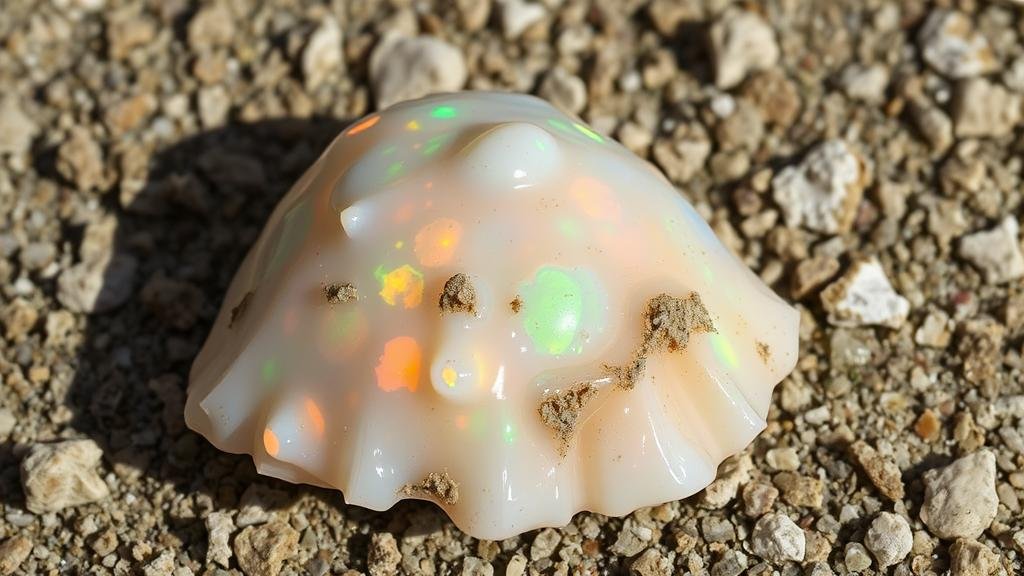Investigating opalized clamshells in the deserts of Nevada, relics of ancient seas.
Investigating Opalized Clamshells in the Deserts of Nevada
The deserts of Nevada, with their stark landscapes and rugged terrain, may seem an unlikely location for fossilized marine life. But, beneath the arid surface lies an incredible geological history that tells a story of ancient seas. One of the most intriguing aspects of this history is the presence of opalized clamshells, which serve as captivating relics for rockhounds and mineral collectors. This article delves into the formation, significance, and collection tips for these unique fossils.
The Formation of Opalized Clamshells
Opalization is a fascinating geological process where the mineral opal replaces the original organic material of shells and bones. Over millions of years, the clamshells buried under sediment became saturated with silica-laden groundwater. As the original calcium carbonate gradually dissolved, silica was deposited in its place, leading to the creation of opal. This process can take thousands of years, and the result is a stunning, vibrant fossil that showcases various colors ranging from deep blues to radiant reds.
According to geological studies, opalized fossils are often found in sedimentary rock formations. In Nevada, locations such as the Frenchman Flat and the Amargosa Valley are known for yielding these prized specimens. The opalized shells are remnants of the Tertiary period, approximately 55 to 2.6 million years ago, indicating a time when this region was submerged under the ancient Nevada Sea.
Noteworthy Characteristics
What sets opalized clamshells apart as collectibles is their unique visual appeal and the rich history they encapsulate. Featuring iridescent colors and interesting patterns, they provide both aesthetic value and scientific significance. Many collectors are drawn to the following characteristics:
- Color Play: The microstructure of opal lends itself to a phenomenon called play-of-color, which displays changing hues when viewed from different angles.
- Unique Patterns: Each specimen may exhibit individual patterns due to variations in mineral deposition, making each piece distinct.
- Fossilization Process: Understanding the geological processes behind opalization provides valuable insights for both collectors and researchers.
Location and Collection Tips
For aspiring collectors and seasoned rockhounds, knowing where to look is crucial. While seeking out opalized clamshells in Nevada, consider the following tips:
- Research Geological Maps: Familiarize yourself with local topography and sedimentary rock formations. Geological maps can highlight promising areas.
- Use Tools: Equip yourself with a hammer, chisel, safety goggles, and gloves to safely excavate fossils from rock formations.
- Respect Regulations: Ensure to adhere to local laws and regulations regarding fossil collection, especially in protected areas.
- Join Rockhounding Clubs: Networking with local rockhounding communities can provide valuable tips and potentially collaborative collections.
Real-World Applications and Significance
Beyond their visual beauty, opalized clamshells hold significant educational and scientific value. They play an essential role in paleontology by offering insight into ancient environmental conditions and marine ecosystems. The study of these fossils can help scientists understand climate changes and shifts in species diversity over millions of years.
Also, opalized clamshells serve as unique conversation pieces in the realm of geology and paleontology. Collectors often find that learning about the geological background of their pieces enhances their appreciation for these treasures.
Conclusion: Actionable Takeaways
Investigating opalized clamshells in Nevada not only enriches our understanding of the earth’s history but also presents an exciting opportunity for collectors. By equipping themselves with knowledge and tools, rockhounds can uncover these spectacular fossilized relics. Remember to respect the natural environment and uphold ethical collecting practices while pursuing these breathtaking geological marvels.



